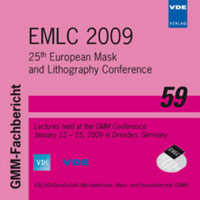Contamination control for ArF photo masks
Conference: EMLC 2009 - 25th European Mask and Lithography Conference
01/12/2009 - 01/15/2009 at Dresden, Germany
Proceedings: EMLC 2009
Pages: 13Language: englishTyp: PDF
Personal VDE Members are entitled to a 10% discount on this title
Authors:
Gordon, Joseph S.; Connolly, Brid; Frisa, Larry; Chovino, Christian; Weins, Colleen (Toppan Photomasks, Inc., 131 Old Settlers Blvd., Round Rock, Texas, USA)
Silova, Marianna; Huijbregtse, Jeroen; Maxim, Nicolae (ASML Netherlands B.V., De Run 6501, 5504 DR Veldhoven, The Netherlands)
Abstract:
Advanced photolithography tools use 193 nanometer wavelength light for conventional and immersion printing. The increased energy of 193 nm (ArF) light coupled with the higher absorption cross section of most materials has lead to a dramatic increase in the rate of haze formation as compared to previously used lithographic wavelengths (248 KrF and 365 nm i-line systems). It is well known that at this short wavelength photochemical reactions are enhanced leading to progressive defect formation, or haze, on optical surfaces within microlithography tools. Therefore, strict contamination control of the optics environment is needed to avoid cumulative effects. Such measures have been implemented in lithography tools both for the optics and for the reticle during exposure. However, the patterned side of the photomask is the most sensitive element in the litho optical path for haze growth, because it is in focus and small defects will show up as printing defects. Moreover, the reticle life time depends both on rigorous contamination control for expose and transport/storage conditions (both inside and outside of the lithography tool). The litho operating cost depends directly on reticle life time. It is imperative that the industry takes the required measures to improve the airborne molecular contamination levels both in the storage part of the photolithography tool and in devices used to transport reticles outside of the tool to slow down reticle haze Past studies have shown the large effects of humidity and AMC on haze growth during storage and exposure. Therefore, significant improvements in storage and exposure environment have been implemented by many fabs to reduce the frequency of haze failures. It has also been shown that outgassing from materials surrounding the mask can influence or cause haze. It is clear that the reticle must be adequately protected from contamination sources throughout the life cycle of the reticle (both inside and outside of the lithography tool). In this paper we examine improvements in the storage conditions of reticles inside the lithography tool as well as improvements in commercial SMIF pods used in fab storage and automated handling of reticles.


